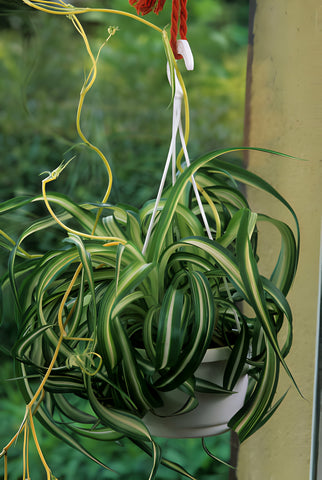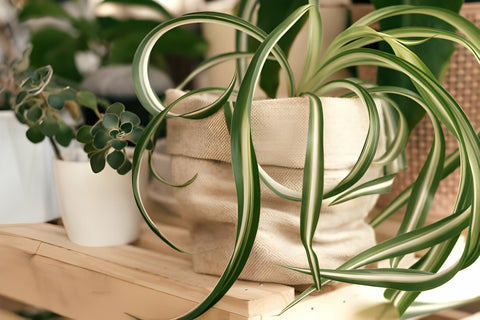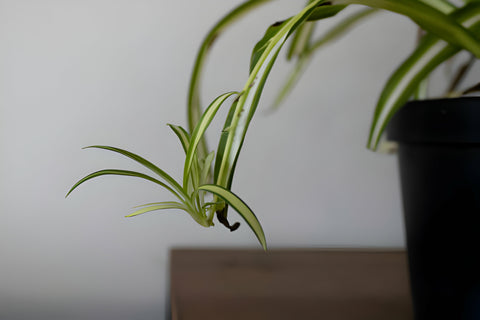Spider plants (Chlorophytum comosum) are widely loved for their unique look and easy care, making them popular houseplants. Now, imagine a variety of these well-known Spider plants, but with a playful twist – that's the Bonnie Curly Spider! Compared to the standard Spider Plant, Bonnie is smaller and more compact, bringing a charming, curly flair to the classic favorite.
Cultivated from Africa and is part of the Asparagaceae family, Bonnie Spider plants’ charm lies in the long, curly leaves that gracefully cascade down from baskets or hanging pots, creating a visually appealing and elegant display. The slender, arching leaves contribute to the plant's common name, as they resemble the legs of a spider. One of the key features of these houseplants is the production of "spiderettes" or offsets. These miniature plantlets, often referred to as "babies" or "pups", dangle from the mother plant on thin, wiry stems, looking like spiders on a web. As these offsets mature, they can be easily propagated to grow new spider plants, making them an excellent choice for those looking to expand their indoor plant collection or share the joy of gardening with others.
Spider plant’s popularity as a houseplant comes from its ability to thrive in various environments, making it accessible and enjoyable for both novice and seasoned plant enthusiasts.
[Air-purifying Ability]Bonnie Curly Spider Plant – One of The Best Air-Purifying Houseplants!
Bonnie spider plants are not just visually appealing, but they also serve as air-purifying wonders. According to NASA's research, spider plants have the remarkable ability to eliminate 95% of airborne chemicals within 24 hours. Like other spider plant varieties, Bonnie is known for its capacity to absorb and neutralize certain toxins present in the air. It achieves this through a process called phytoremediation, where the plant takes up pollutants through its leaves and roots, converting or storing them in a less harmful form. Specifically, spider plants, including Bonnie, are adept at removing substances like formaldehyde and xylene, which can be found in various household products. This natural air-purifying ability makes Bonnie Curly Spider Plant a practical and attractive choice for enhancing indoor air quality. This curly spider plant acts as an efficient filter, targeting and removing various toxins, including harmful carbon monoxide, contributing significantly to improved indoor air quality. This makes spider plants not only aesthetically pleasing but also invaluable additions to indoor environments, promoting a healthier and more breathable atmosphere.
Is Bonnie Curly Spider Plant Pet-friendly?
Bonnie Curly Spider Plant (Chlorophytum comosum 'Bonnie') is generally considered safe for pets. Spider plants, in general, are non-toxic to cats and dogs. However, it's essential to note that individual pets may react differently, and there is always some level of variability in how animals respond to plants. If you suspect that your pet has ingested any part of the Bonnie Spider Plant and is showing signs of illness, it's advisable to contact your veterinarian for guidance. While spider plants are usually considered pet-friendly, monitoring your pets' behavior around plants is a good practice to ensure their well-being.
With its charming curly leaves, air-purifying qualities, and safety for pets, the Bonnie Spider Plant brings both aesthetic appeal and peace of mind to plant enthusiasts and pet owners alike.
General Care
Lighting
Bonnie Curly Spider Plant has remarkable adaptability to varying lighting conditions, making it a versatile and resilient houseplant. Although it can thrive in medium to lower light levels, it demonstrates accelerated growth when exposed to bright, indirect light. This plant's versatility extends to its ability to flourish in shady spots, where it exhibits slower growth without compromising the overall health of its leaves. It's crucial to monitor your Bonnie Curly Spider Plant's response to light levels for optimal health and appearance. If the plant receives insufficient light, it may exhibit elongated growth and produce fewer spiderettes. Conversely, an excess of light can result in pale or yellowing leaves. By maintaining a careful balance in its exposure to light, you can ensure the Bonnie Curly Spider Plant remains vibrant, producing ample spiderettes and showcasing its captivating beauty.
For optimal results, consider placing your Curly Spider Plant near an east-facing window to benefit from the gentle morning sunlight, or opt for a south-facing window, providing a consistent source of indirect light throughout the day. In the winter, consider using a grow lamp if your room does not have enough natural light.

Hanging is an attractive way to grow Curly Spider Plant 'Bonnie'.
Photo by Michel VIARD
Watering
Maintaining the optimal moisture balance is key to the well-being of the Bonnie Curly Spider Plant. This adaptable houseplant appreciates relatively moist soil, and unlike some plants, it doesn't mind water on its leaves. When deciding on the watering schedule, wait until the top half of the soil is dry before giving your spider plant a thorough watering. You can gauge soil moisture by using your finger or a moisture meter. Be sure to let all excess water drain completely from the pot after each watering to avoid waterlogging, which may lead to root rot. In colder months, reduce the frequency of watering.
Spider plants prefer to be kept evenly moist but can tolerate periods of drought. Avoid overwatering, as it can lead to root rot. When watering, provide a deep soak, allowing excess water to drain out of the bottom of the pot. Empty the saucer under the pot to prevent the plant from sitting in standing water, which can also contribute to root rot. The frequency of watering depends on factors such as pot size, soil type, temperature, and light levels. Adjust your watering frequency based on the specific conditions of your environment. In winter or low-light conditions, Spider plants may require less frequent watering. For optimal results, use rainwater or distilled water to avoid mineral build-up in the soil.
Soil And Fertilizer
Bonnie Curly Spider Plant is adaptable to various soil types, as long as they are well-draining, loamy, and has a slightly moist condition. It's crucial to use a soil mix that doesn't retain water for extended periods and to opt for a pot with drainage holes. You can mix your own soil using houseplant potting soil, bark and perlite. This type of potting mix is loose and porous, allowing for good airflow and water drainage while still retaining moisture. If you prefer a soilless medium, select one containing peat moss, perlite, vermiculite, and sand.
Fertilize the plant once a month during the growing season (spring/summer) with a diluted liquid fertilizer. Ensure the soil mix retains moisture while allowing for proper drainage and aeration. A loose and porous potting mix encourages good airflow and water drainage, creating an ideal environment for the plant. When fertilizing, apply a balanced houseplant fertilizer directly to the soil, avoiding contact with the fronds or plant center. It's advisable to refrain from fertilizing in winter or low-light conditions to prevent fertilizer burn.

The curly leaves make Bonnie Spider Plant stand out from the standard one.
Photo by Tatiana Buzmakova
Temperature And Humidity
Bonnie Curly Spider Plant thrives within a temperature range of 60 to 75°F, with the capacity to endure as low as 50°F and as high as 90°F, although extreme temperatures may harm the plant. It's crucial to note that this plant is not frost-tolerant and cannot withstand temperatures below 40°F. You should also keep this plant away from cold drafts, heating vents, fireplaces, and other areas with fluctuating temperatures.
In terms of humidity preferences, Bonnie Spider Plant favors moderate to high levels, ideally around 40-60%. While it can tolerate lower humidity environments, providing additional moisture, such as misting or using a humidifier, encourages faster growth. You can also group several plants to create a microclimate with higher humidity levels or place a tray filled with water and pebbles near the plant to increase humidity as the water evaporates.
Extra Care
Potting And Repotting
Choosing the right type of pot for the Bonnie Curly Spider Plant is crucial for its well-being. Opt for a container with drainage holes, as this ensures proper water drainage and prevents waterlogging, which can lead to root rot. Additionally, consider pots made from breathable materials such as concrete, terracotta, or ceramic. These materials promote better airflow to the roots, contributing to a healthier root environment. The choice of a suitable pot for the Bonnie Curly Spider Plant plays a significant role in maintaining optimal soil moisture levels and preventing potential issues associated with water retention.
Repotting should be considered when the plant outgrows its current container or when the soil becomes depleted of nutrients. This is typically done every two to three years, preferably during the active growth phases in spring or summer. When repotting, transition to a container that is one size larger than the current pot to allow for the plant's continued development. Ensuring proper potting and repotting practices contributes to the Bonnie Curly Spider Plant's well-being and longevity.
Pruning
Pruning is a simple yet essential practice for maintaining your spider plant’s overall health and appearance. This process involves regular inspections to identify any yellow or withered leaves, which should be trimmed at the base to keep the plant neat and vibrant. If the plant exhibits leggy or elongated growth, strategically trim the stems just above a leaf node to encourage a denser and more compact form. Post-flowering, focus on pruning the flowering stems by cutting them just above a healthy set of leaves. Shaping the plant for a desired form or size can also be achieved by trimming the tips of the stems. This ongoing pruning routine, carried out throughout the growing season, ensures the Bonnie Curly Spider Plant remains aesthetically pleasing while promoting robust and vigorous growth. Additionally, regularly cleaning and disinfecting pruning tools between uses is a good practice to safeguard the plant from potential harm and ensure a thriving and attractive appearance.
Propagation
Propagating your Bonnie Curly Spider Plant can be a fun project, and it's important to follow some simple steps for success. First, pick strong baby plants (spiderettes) with at least five leaves and about 5cm long. Make sure they're mature enough to grow on their own. Check that the parent plant is healthy, free from pests, diseases, or signs of stress like brown-tipped leaves. If there are pests, deal with them before starting the propagation process. Remember, propagating is not a fix for a struggling plant. If the main plant is not doing well, try to solve its issues first before growing new plants. Timing matters, so try to do this during the plant's active growth period, usually in warmer months. This helps the baby plants settle in faster without too much stress.

Spider Plant can be propagated by spiderettes or offsets.
Photo by Samantha Locking
After removing your baby spiderettes, plant them in water or soil. For soil propagation, use well-draining and slightly moistened soil. For water propagation, use only clean distilled water and change it regularly at least once a week. Give your baby plants plenty of indirect bright light, high humidity, and stable temperatures.
Don’t forget to keep your tools clean and sharp. Clean cuts reduce the chance of infection and help the plants heal faster. Have fun growing new curly spider plants!
Common Problems
Bonnie is easy-care but not trouble-free. One common issue is browning or yellowing of the leaves. This might be due to overwatering, so make sure the soil is drying out between waterings. Spider plants, including Bonnie, prefer their soil to dry out between waterings. If the soil remains consistently soggy, it can lead to root rot. Adjust your watering routine and ensure the pot has drainage holes to prevent waterlogged soil.
If the leaves are turning pale, it could be a sign of too much sunlight. Adjust the plant's location to a spot with bright, indirect light.
Another challenge could be pests, like spider mites or aphids. Keep an eye on your plant and treat any pests promptly. Cleaning the leaves regularly can also help prevent infestations.
Occasionally, the plant might develop brown tips on its leaves. This could be a result of dry air or uneven watering. Consider increasing humidity or adjusting your watering routine.
While this plant is generally adaptable to low-light conditions, under long periods of very low light, Bonnie spider plant might exhibit leggy growth, with stretched-out stems and sparse foliage. To prevent this, try to provide bright, indirect light for a few hours each day.
Remember, plants can sometimes take time to adjust to new environments, so be patient if you notice changes. If problems persist, check the plant's conditions and make adjustments accordingly.





























